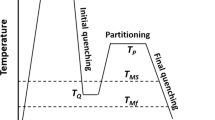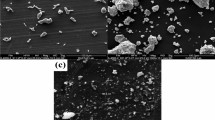Abstract
In this work, high-cycle fatigue is studied for threaded cylindrical high-strength steel samples coated using three different industrial processes: black oxidation, normal-temperature galvanization and high-temperature galvanization. The fatigue performance in air is compared with that of uncoated samples. Microstructural characterization revealed the abundant presence of small cracks in the zinc coating partially penetrating into the steel. This is consistent with the observation of multiple crack initiation sites along the thread in the galvanized samples, which led to crescent type fracture surfaces governed by circumferential growth. In contrast, the black oxidized and uncoated samples exhibited a semicircular segment type fracture surface governed by single-sided growth with a significantly longer fatigue life. Numerical fatigue life prediction based on an extended Paris-law formulation has been conducted on two different fracture cases: 2D axisymmetric multisided crack growth and 3D single-sided crack growth. The results of this upper-bound and lower-bound approach are in good agreement with experimental data and can potentially be used to predict the lifetime of bolted components.



















Similar content being viewed by others
Abbreviations
- a :
-
Crack length (mm)
- a 0 :
-
Intrinsic crack length (mm)
- a c :
-
Critical crack length at fracture
- a e :
-
Effective crack length (mm)
- a i :
-
Crack length increment (mm)
- a ini :
-
Initial crack length (mm)
- b :
-
Basquin law exponent
- c :
-
Notch depth (mm)
- d :
-
Nominal diameter or diameter of steel core (mm)
- d 2 :
-
Pitch diameter (mm)
- r e :
-
Effective radius (mm)
- k t :
-
Theoretical stress concentration factor
- l c :
-
Distance between cracks in coating (mm)
- n, p, q :
-
Stage-1, Stage-2 and Stage-3 growth exponents
- n x , n y :
-
Number of divisions in x-direction and y-direction, respectively
- r :
-
Notch root radius (mm)
- t c :
-
Coating thickness (mm)
- x, y :
-
Cartesian coordinates in the crack plane (mm)
- A eff :
-
Effective cross-sectional area (mm2)
- C th, C :
-
Stage-1 and Stage-2 growth parameter
- \(\hat{C}\) :
-
Basquin law parameter
- E c :
-
Elastic modulus of zinc coating (MPa)
- E s :
-
Elastic modulus of steel (substrate) MPa
- F a :
-
Load amplitude (kN)
- F m :
-
Mean load (kN)
- G max, G c :
-
Maximum Mode-1 SERR at peak load or critical SERR release rate (J/mm2)
- K c :
-
Fracture toughness of steel material (MPa \(\sqrt {\text{mm}}\))
- K max :
-
Maximum stress intensity factor at peak load (MPa \(\sqrt {\text{mm}}\))
- K op :
-
Opening stress intensity factor (MPa \(\sqrt {\text{mm}}\))
- L :
-
Length (mm)
- N, N tot :
-
Number of cycles, number of cycles to failure
- R :
-
Load ratio/R-ratio
- T :
-
Ambient temperature (K)
- T sol :
-
Solidification temperature of coating (K)
- X, Y, Z :
-
Cartesian coordinates in the sample coordinate system (mm)
- Α :
-
Constraint factor α = 1 for plane stress or crack closure parameter or tensile stress concentration pre-factor α = 2
- α c :
-
Linear coefficient of thermal expansion of coating (K−1)
- α s :
-
Linear coefficient of thermal expansion of substrate (K−1)
- ε ij :
-
Green strain tensor
- δ ij :
-
Kronecker delta
- ∆α :
-
Incremental crack spacing or fracture quantum (m)
- ∆σ :
-
Stress range (MPa)
- ∆σ e :
-
Endurance limit range (MPa)
- ∆K :
-
Stress intensity factor range (MPa \(\sqrt {\text{mm}}\))
- ∆K 1 :
-
Stress intensity factor threshold range for R = 1 (MPa \(\sqrt {\text{mm}}\))
- ∆K th :
-
Stress intensity factor threshold range for R ≥ 0 (MPa \(\sqrt {\text{mm}}\))
- ν :
-
Poisson’s ratio
- σ 0 :
-
Flow stress of parent material (MPa)
- σ a :
-
Nominal stress amplitude (MPa)
- σ e :
-
Endurance limit amplitude (MPa)
- σ m :
-
Nominal mean stress (MPa)
- σ max :
-
Maximum nominal stress level (MPa)
- σ min :
-
Minimum nominal stress level (MPa)
- σ u :
-
Nominal ultimate tensile strength (MPa)
- σ y :
-
Nominal yield strength (MPa)
- σ T :
-
Maximum thermal equi-biaxial stress in coating (MPa)
References
Y. Bergengren and A. Melander, An Experimental and Theoretical-Study of the Fatigue Properties of Hot-Dip-Galvanized High-Strength Sheet Steel, Int. J. Fatigue, 1992, 14, p 154–162
T. Nilsson, G. Engberg, and H. Trogen, Fatigue Properties of Hot-Dip Galvanised Steels, Scand. J. Metall., 1989, 18, p 166–175
M. Oechsner, J. Beyer, F. Simonsen, P. Schaumann, and R. Eichstädt, Experimental and Analytical Assessment of the Fatigue Strength of Bolts with Large Dimensions Under Consideration of Boundary Layer Effects, in METEC & 2nd European Steel Technology and Application Days (Düsseldorf, Germany) 2015, p 1–6.
P. Schaumann and R. Eichstädt, Fatigue Assessment of High-Strength Bolts with Very Large Diameters in Substructures for Offshore Wind Turbines, in Proceedings of the 25th International Ocean and Polar Engineering Conference (ISOPE, Hawaii, USA) 2015, p 260–267.
P. Schaumann and R. Eichstädt, Ermüdung sehr großer HV-Schraubengarnituren, Stahlbau, 2016, 85, p 604–611 (in German)
DIN, Eurocode 3: Design of steel structures—Part 1-9: Fatigue, Standard, German version, DIN Deutsches Institut fu¨r Normung e.V. (Berlin, Germany, 2005 in German).
R. Schneider, Örtliche, Bewertung der Schwingfestigkeit von Gewindeverbindungen, Darmstadt Technische Universitat, Ph.D. thesis (2010 in German).
CEN, Eurocode 3: Design of steel structures—Part 1-8: Design of joints, Standard, European Committee for Standardization, Management Centre (Brussels, Belgium) 2005.
CEN, High-strength structural bolting assemblies for preloading. System HRC. Bolt and nut assemblies with calibrated preload, Standard, BSI: FME/9 (London, UK) 2009.
Dassault Systèmes, Abaqus Analysis user’s manual, Vol. 6.16, 2016.
Dassault Systèmes, SolidWorks 3D mechanical CAD software, Reference Guide, 2016.
R. Krueger, Virtual Crack Closure Technique: History, Approach, and Applications, Appl. Mech. Rev., 2004, 57, p 109–143
NASA Johnson space center and southwest research institute, NASGRO Fracture mechanics and fatigue crack growth analysis software 4.0 Manual, 2002.
R.G. Forman and S.R. Mettu, Behavior of surface and corner cracks subjected to tensile and bending loads in a Ti-6Al-4V alloy, Technical Report NASA-TM-102165, NASA Johnson Space Center (Houston, USA) 1990.
J. Newman, A Crack Opening Stress Equation for Fatigue Crack-Growth, Int. J. Fracture, 1984, 24, p 131–135
R. Forman, V. Shivakumar, J. Cardinal, L. Williams, and P. McKeighan, Fatigue crack growth database for damage tolerance analysis, Technical Report DOT/FAA/AR-05/15, NASA Johnson Space Center (Houston, USA) 2005.
The MathWorks, Inc., MATLAB and Statistics Toolbox Release 2015a (Natick, USA) 2014.
G. Reumont, J.B. Vogt, A. Iost, and J. Foct, The Effects of an Fe-Zn Intermetallic-Containing Coating on the Stress Corrosion Cracking Behavior of a Hot-Dip Galvanized Steel, Surf. Coat. Technol., 2001, 139, p 265–271
J. Hutchinson and Z. Suo, Mixed-Mode Cracking In Layered Materials, Adv. Appl. Mech., 1992, 29, p 63–191
M. Thouless, Crack Spacing in Brittle Films on Elastic Substrates, J. Am. Ceram. Soc., 1990, 73, p 2144–2146
M. Thouless, E. Olsson, and A. Gupta, Cracking of Brittle Films on Elastic Substrates, Acta Metall. Mater., 1992, 40, p 1287–1292
Z. Xia and J. Hutchinson, Crack Patterns in Thin Films, J. Mech. Phys. Solids, 2000, 48, p 1107–1131
J. Beuth, Cracking of Thin Bonded Films in Residual Tension, Int. J. Solids Struct., 1992, 29, p 1657–1675
H. Tada, P. Paris, and G. Irwin, The Stress Analysis of Cracks Handbook, American Society of Mechanical Engineers, New York, 2000
N. Pugno and R. Ruoff, Quantized Fracture Mechanics, Phil. Mag., 2004, 84, p 2829–2845
N. Pugno, M. Ciavarella, P. Cornetti, and A. Carpinteri, A generalized Paris’ Law for Fatigue Crack Growth, J. Mech. Phys. Solids, 2006, 54, p 1333–1349
M. Ashby, H. Shercliff, and D. Cebon, Materials: Engineering, Science, Processing and Design, Elsevier, Amsterdam, 2014
O. Basquin, The Exponential law of Endurance Tests, ASTM, 1910, 10, p 625–630
J. Dundurs, Discussion: Edge-Bonded Dissimilar Orthogonal Elastic Wedges Under Normal and Shear Loading, J. Appl. Mech., 1969, 36, p 650–652
Z.B. Zhang, O.V. Mishin, N.R. Tao, and W. Pantleon, Microstructure and Annealing Behavior of a Modified 9Cr-1Mo Steel After Dynamic Plastic Deformation to Different Strains, J. Nucl. Mater., 2015, 458, p 64–69
Z.B. Zhang, Y.B. Zhang, O.V. Mishin, N.R. Tao, W. Pantleon, and D. Juul Jensen, Microstructural Analysis of Orientation-Dependent Recovery and Recrystallization in a Modified 9Cr-1Mo Steel Deformed by Compression at a High Strain Rate, Metall. Mater. Trans. A, 2016, 47, p 4682–4693
M.F. Garwood, H.H. Zurburg, and M.A. Erickson, Correlation of Laboratory Tests and Service Performance: Interpretation of Tests and Correlation with Service, American Society for Metals, Cleveland, 1951
D. Tullock, I. Reimanis, A. Graham, and J. Petrovic, Deflection and Penetration of Cracks at an Interface Between 2 Dissimilar Materials, Acta Metall. Mater., 1994, 42, p 3245–3252
A. Dimatteo, G. Lovicu, M. Desanctis, R. Valentini, and M. Salvati, Influence of Galvanizing Process on Fatigue Resistance of Microalloyed Steels, Convegno Nazionale IGF XXI, (Cassino, Italy) 2011, p 283–291.
P.P. Milella, Fatigue and Corrosion in Metals, Springer, Milan, 2013
Acknowledgments
This work was supported by the Department of Wind Energy within the cross-sectional activity program. The authors acknowledge H.L. Toftegaard, J. Sjølin and L. Lorentzen for their technical assistance.
Author information
Authors and Affiliations
Corresponding author
Rights and permissions
About this article
Cite this article
Eder, M.A., Haselbach, P.U. & Mishin, O.V. Effects of Coatings on the High-Cycle Fatigue Life of Threaded Steel Samples. J. of Materi Eng and Perform 27, 3184–3198 (2018). https://doi.org/10.1007/s11665-018-3399-2
Received:
Revised:
Published:
Issue Date:
DOI: https://doi.org/10.1007/s11665-018-3399-2




